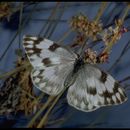North American Ecology (US and Canada)
provided by North American Butterfly Knowledge Network
Resident in western North America (Scott 1986). Habitats are NATURAL, SOMETIMES DISTURBED, OPEN AREAS. Host plants are usually herbaceous including many species, but mostly in one family, CRUCIFERAE. Eggs are laid on the host plant singly. Individuals overwinter as pupae. There is a variable number of flights based on latitude each year with the approximate flight time JUN1-JUL1 in the northern part of the range and MAY1-JUN1 in the southern part of their range (Scott 1986). Listed as a subspecies of Pieris callidice by some sources (Scott, 1986).
Conservation Status
provided by University of Alberta Museums
Not of concern.
- license
- cc-by-nc
- copyright
- University of Alberta Museums
Cyclicity
provided by University of Alberta Museums
Single- to multi-brooded, depending on the habitat, flying from April into September.
- license
- cc-by-nc
- copyright
- University of Alberta Museums
Distribution
provided by University of Alberta Museums
The Western White ranges from Alaska to western Ontario, south to California and New Mexico (Opler 1999).
- license
- cc-by-nc
- copyright
- University of Alberta Museums
General Description
provided by University of Alberta Museums
"The Western White along with the other two Pontia whites, form a group of very similar species. The Spring White (Pontia sisymbrii) is easiest to distinguish; the dark vein markings on the hindwing underside are not connected laterally, and it occurs only in montane woodlands and extreme northern Alberta. The Western and Checkered White (P. protodice) are more difficult to separate. Males of the Western are more heavily marked than the Checkered, particularly on the underside. Females of both species have heavier markings than the males, but these markings are brown in P. protodice, not charcoal or black. Another characteristic is found on the underside of the forewing apex: P. occidentalis has the dark submarginal band connected with dark markings along the veins to the wing margin, P. protodice has only pale yellow scales here.
Individuals of the spring generation are smaller and have darker underside markings. Alberta populations are the nominate subspecies.
"
- license
- cc-by-nc
- copyright
- University of Alberta Museums
Habitat
provided by University of Alberta Museums
Non-forested habitats throughout the province, particularly grasslands and alpine meadows.
- license
- cc-by-nc
- copyright
- University of Alberta Museums
Life Cycle
provided by University of Alberta Museums
The eggs are a dull orange colour. Mature larvae are blue-grey with a yellow dorsal and lateral stripe, and many black dots. Pupae are light grey with small black spots, and overwinter (Layberry et al. 1998, Guppy & Shepard 2001). Males display hilltopping behaviour, and can sometimes be found on mountain peaks over 3000m. In the mountains, there is only one brood that emerges in late spring, but there are two (sometimes a partial third) broods at lower elevations (Bird et al. 1995). This is our most common species of Pontia.
- license
- cc-by-nc
- copyright
- University of Alberta Museums
Trophic Strategy
provided by University of Alberta Museums
Although this is often a very common species, there are no larval foodplant records for Alberta. Wild mustards (Brassicaeae) are recorded elsewhere, including Lepidium, Cleome, Draba, Sisymbrium and Thlaspi (Layberry et al. 1998, Guppy & Shepard 2001).
- license
- cc-by-nc
- copyright
- University of Alberta Museums
Pontia occidentalis
provided by wikipedia EN
Pontia occidentalis, the western white, is a butterfly in the family Pieridae. It is found in Western North America.
The wingspan is 38 to 53 millimeters. The host plants are from the mustard or cabbage family, Brassicaceae. The caterpillars eat especially the flowers, buds and fruit. In the north of the range, one generation flies in June and July; in the south two generations fly from May to August.

- license
- cc-by-sa-3.0
- copyright
- Wikipedia authors and editors
Pontia occidentalis: Brief Summary
provided by wikipedia EN
Pontia occidentalis, the western white, is a butterfly in the family Pieridae. It is found in Western North America.
The wingspan is 38 to 53 millimeters. The host plants are from the mustard or cabbage family, Brassicaceae. The caterpillars eat especially the flowers, buds and fruit. In the north of the range, one generation flies in June and July; in the south two generations fly from May to August.
- license
- cc-by-sa-3.0
- copyright
- Wikipedia authors and editors

